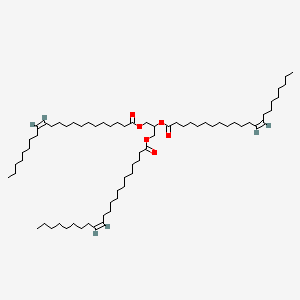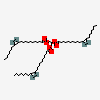Trierucin
- Trierucin
- 2752-99-0
- Glyceryl trierucate
- Glycerol trierucate
- Trierucate
- Create:2005-03-27
- Modify:2025-01-18

- erucic acid triglyceride
- glycerol trierucate
- trierucate
- trierucin
- Trierucin
- 2752-99-0
- Glyceryl trierucate
- Glycerol trierucate
- Trierucate
- Erucin, tri-
- Erucic acid triglyceride
- Tri(Z-13-docosenoyl)glycerol
- Glyceryl tri(cis-13-docosenoate)
- 13-Docosenoin, tri-, (Z,Z,Z)-
- 2,3-bis[[(Z)-docos-13-enoyl]oxy]propyl (Z)-docos-13-enoate
- Propane-1,2,3-triyl tris((Z)-docos-13-enoate)
- I0IDQ0M20R
- 1,2,3-Propanetriol tri(13-docosenoate)
- 13-Docosenoic acid, 1,1',1''-(1,2,3-propanetriyl) ester, (13Z,13'Z,13''Z)-
- 1,2,3-tri-(13Z-docosenoyl)-glycerol
- 13-Docosenoic acid, 1,2,3-propanetriyl ester, (Z,Z,Z)-
- TG(22:1/22:1/22:1)
- TG(22:1(13Z)/22:1(13Z)/22:1(13Z))
- EINECS 220-399-7
- UNII-I0IDQ0M20R
- 13-Docosenoic acid, 1,2,3-propanetriyl ester
- 1,2,3-Tri(cis-13-docosenoyl) Glycerol
- Tri-13(Z)-Docosenoin
- Glycerol Tri-13-docosenoate
- SCHEMBL712083
- CHEMBL4297655
- XDSPGKDYYRNYJI-IUPFWZBJSA-N
- DTXSID401021942
- GLYCERYL TRIERUCATE [VANDF]
- CAA75299
- GLYCERYL TRIERUCATE [MART.]
- HY-N7055
- 13-Docosenoic acid, 1,2,3-propanetriyl ester, (13Z,13'Z,13''Z)-
- GLYCERYL TRIERUCATE [WHO-DD]
- LMGL03012438
- MFCD00056321
- AKOS040759352
- DB12528
- 1,2,3-Tri-13(Z)-Docosenoyl Glycerol
- DA-59777
- MS-31902
- (Z)-13-DOCOSENOIC ACID TRIGLYCERIDE
- CS-0100518
- NS00014170
- T1390
- F82435
- J-016802
- 1,2,3-Propanetriyl ester(Z,Z,Z)-13-Docosenoic acid
- Q15726025
- TG 22:1_22:1_22:1
1075.96 100
737.6426 60.06
715.6601 100
1071.005 3.34
1053.978 1.67
- Extracellular
- Membrane
Not Classified
Reported as not meeting GHS hazard criteria by 18 of 18 companies. For more detailed information, please visit ECHA C&L website.
Aggregated GHS information provided per 18 reports by companies from 1 notifications to the ECHA C&L Inventory.
Reported as not meeting GHS hazard criteria per 18 of 18 reports by companies. For more detailed information, please visit ECHA C&L website.
There are 0 notifications provided by 0 of 18 reports by companies with hazard statement code(s).
Information may vary between notifications depending on impurities, additives, and other factors. The percentage value in parenthesis indicates the notified classification ratio from companies that provide hazard codes. Only hazard codes with percentage values above 10% are shown.
Patents are available for this chemical structure:
https://patentscope.wipo.int/search/en/result.jsf?inchikey=XDSPGKDYYRNYJI-IUPFWZBJSA-N
- CAS Common ChemistryLICENSEThe data from CAS Common Chemistry is provided under a CC-BY-NC 4.0 license, unless otherwise stated.https://creativecommons.org/licenses/by-nc/4.0/1,1′,1′′-(1,2,3-Propanetriyl) tri-(13Z)-13-docosenoatehttps://commonchemistry.cas.org/detail?cas_rn=2752-99-0
- ChemIDplus13-Docosenoic acid, 1,2,3-propanetriyl esterhttps://pubchem.ncbi.nlm.nih.gov/substance/?source=chemidplus&sourceid=0002752990ChemIDplus Chemical Information Classificationhttps://pubchem.ncbi.nlm.nih.gov/source/ChemIDplus
- DrugBankLICENSECreative Common's Attribution-NonCommercial 4.0 International License (http://creativecommons.org/licenses/by-nc/4.0/legalcode)https://www.drugbank.ca/legal/terms_of_useGlyceryl Trierucatehttps://www.drugbank.ca/drugs/DB12528
- EPA DSSToxPropane-1,2,3-triyl tris((Z)-docos-13-enoate)https://comptox.epa.gov/dashboard/DTXSID401021942CompTox Chemicals Dashboard Chemical Listshttps://comptox.epa.gov/dashboard/chemical-lists/
- European Chemicals Agency (ECHA)LICENSEUse of the information, documents and data from the ECHA website is subject to the terms and conditions of this Legal Notice, and subject to other binding limitations provided for under applicable law, the information, documents and data made available on the ECHA website may be reproduced, distributed and/or used, totally or in part, for non-commercial purposes provided that ECHA is acknowledged as the source: "Source: European Chemicals Agency, http://echa.europa.eu/". Such acknowledgement must be included in each copy of the material. ECHA permits and encourages organisations and individuals to create links to the ECHA website under the following cumulative conditions: Links can only be made to webpages that provide a link to the Legal Notice page.https://echa.europa.eu/web/guest/legal-noticePropane-1,2,3-triyl tris[(Z)-docos-13-enoate]https://echa.europa.eu/substance-information/-/substanceinfo/100.018.545Propane-1,2,3-triyl tris[(Z)-docos-13-enoate] (EC: 220-399-7)https://echa.europa.eu/information-on-chemicals/cl-inventory-database/-/discli/details/80384
- FDA Global Substance Registration System (GSRS)LICENSEUnless otherwise noted, the contents of the FDA website (www.fda.gov), both text and graphics, are not copyrighted. They are in the public domain and may be republished, reprinted and otherwise used freely by anyone without the need to obtain permission from FDA. Credit to the U.S. Food and Drug Administration as the source is appreciated but not required.https://www.fda.gov/about-fda/about-website/website-policies#linkingGLYCERYL TRIERUCATEhttps://gsrs.ncats.nih.gov/ginas/app/beta/substances/I0IDQ0M20R
- Human Metabolome Database (HMDB)LICENSEHMDB is offered to the public as a freely available resource. Use and re-distribution of the data, in whole or in part, for commercial purposes requires explicit permission of the authors and explicit acknowledgment of the source material (HMDB) and the original publication (see the HMDB citing page). We ask that users who download significant portions of the database cite the HMDB paper in any resulting publications.http://www.hmdb.ca/citing
- New Zealand Environmental Protection Authority (EPA)LICENSEThis work is licensed under the Creative Commons Attribution-ShareAlike 4.0 International licence.https://www.epa.govt.nz/about-this-site/general-copyright-statement/13-Docosenoic acid, 1,2,3-propanetriyl ester, (13Z,13'Z,13''Z)-https://www.epa.govt.nz/industry-areas/hazardous-substances/guidance-for-importers-and-manufacturers/hazardous-substances-databases/
- ChEMBLLICENSEAccess to the web interface of ChEMBL is made under the EBI's Terms of Use (http://www.ebi.ac.uk/Information/termsofuse.html). The ChEMBL data is made available on a Creative Commons Attribution-Share Alike 3.0 Unported License (http://creativecommons.org/licenses/by-sa/3.0/).http://www.ebi.ac.uk/Information/termsofuse.html
- ClinicalTrials.govLICENSEThe ClinicalTrials.gov data carry an international copyright outside the United States and its Territories or Possessions. Some ClinicalTrials.gov data may be subject to the copyright of third parties; you should consult these entities for any additional terms of use.https://clinicaltrials.gov/ct2/about-site/terms-conditions#Use
- Cosmetic Ingredient Review (CIR)
- EPA Chemical and Products Database (CPDat)Propane-1,2,3-triyl tris((Z)-docos-13-enoate)https://comptox.epa.gov/dashboard/DTXSID401021942#exposureEPA CPDat Classificationhttps://www.epa.gov/chemical-research/chemical-and-products-database-cpdat
- NORMAN Suspect List ExchangeLICENSEData: CC-BY 4.0; Code (hosted by ECI, LCSB): Artistic-2.0https://creativecommons.org/licenses/by/4.0/NORMAN Suspect List Exchange Classificationhttps://www.norman-network.com/nds/SLE/
- Open TargetsLICENSEDatasets generated by the Open Targets Platform are freely available for download.https://platform-docs.opentargets.org/licenceGLYCERYL TRIERUCATEhttps://platform.opentargets.org/drug/CHEMBL4297655
- FooDBLICENSEFooDB is offered to the public as a freely available resource. Use and re-distribution of the data, in whole or in part, for commercial purposes requires explicit permission of the authors and explicit acknowledgment of the source material (FooDB) and the original publication.https://foodb.ca/aboutTG(22:1(13Z)/22:1(13Z)/22:1(13Z))https://foodb.ca/compounds/FDB095421
- Japan Chemical Substance Dictionary (Nikkaji)
- LIPID MAPSLipid Classificationhttps://www.lipidmaps.org/
- MassBank of North America (MoNA)LICENSEThe content of the MoNA database is licensed under CC BY 4.0.https://mona.fiehnlab.ucdavis.edu/documentation/license
- Metabolomics WorkbenchTG(22:1(13Z)/22:1(13Z)/22:1(13Z))https://www.metabolomicsworkbench.org/data/StructureData.php?RegNo=8793
- SpectraBase(Z)-TRI-13-DOCOSENOINhttps://spectrabase.com/spectrum/BgNTJe8yDPb(Z)-tri-13-docosenoinhttps://spectrabase.com/spectrum/KJQfftZrEry(Z)-TRI-13-DOCOSENOINhttps://spectrabase.com/spectrum/KdIjltnjzLQ
- Springer Nature
- Wikidataglyceryl trierucatehttps://www.wikidata.org/wiki/Q15726025
- PubChem
- Medical Subject Headings (MeSH)LICENSEWorks produced by the U.S. government are not subject to copyright protection in the United States. Any such works found on National Library of Medicine (NLM) Web sites may be freely used or reproduced without permission in the U.S.https://www.nlm.nih.gov/copyright.html
- GHS Classification (UNECE)GHS Classification Treehttp://www.unece.org/trans/danger/publi/ghs/ghs_welcome_e.html
- MolGenieMolGenie Organic Chemistry Ontologyhttps://github.com/MolGenie/ontology/
- PATENTSCOPE (WIPO)SID 404130692https://pubchem.ncbi.nlm.nih.gov/substance/404130692
- NCBI


